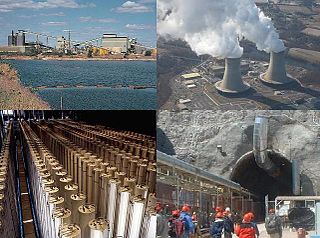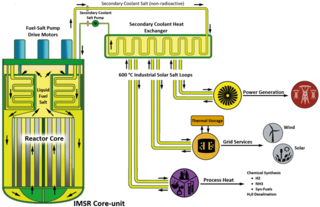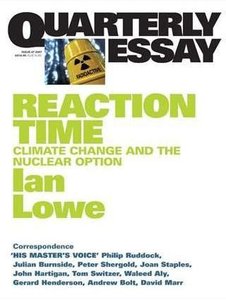 W
WNuclear power is the use of nuclear reactions that release nuclear energy to generate heat, which most frequently is then used in steam turbines to produce electricity in a nuclear power plant. Nuclear power can be obtained from nuclear fission, nuclear decay and nuclear fusion reactions. Presently, the vast majority of electricity from nuclear power is produced by nuclear fission of uranium and plutonium. Nuclear decay processes are used in niche applications such as radioisotope thermoelectric generators. Generating electricity from fusion power remains at the focus of international research. This article mostly deals with nuclear fission power for electricity generation.
 W
WMassimo Aparo is an Italian diplomat, who started working as acting deputy director general and head of the Department of Safeguards, after Tero Varjoranta has resigned effective 11 May 2018.
 W
WContesting the Future of Nuclear Power: A Critical Global Assessment of Atomic Energy is a 2011 book by Benjamin K. Sovacool, published by World Scientific. Sovacool’s book addresses the current status of the global nuclear power industry, its fuel cycle, nuclear accidents, environmental impacts, social risks, energy payback, nuclear power economics, and industry subsidies. There is a postscript on the Japanese 2011 Fukushima nuclear disaster. Based on detailed analysis, Sovacool concludes "that a global nuclear renaissance would bring immense technical, economic, environmental, political, and social costs". He says that it is renewable energy technologies which will enhance energy security, and which have many other advantages.
 W
WThe Doomsday Machine: The High Price of Nuclear Energy, the World's Most Dangerous Fuel is a 2012 book by Martin Cohen and Andrew McKillop which addresses a broad range of concerns regarding the nuclear industry, the economics and environmental aspects of nuclear energy, nuclear power plants, and nuclear accidents. The book has been described by The New York Times as "a polemic on the evils of splitting the atom".
 W
WThe environmental impact of nuclear power results from the nuclear fuel cycle, operation, and the effects of nuclear accidents.
 W
WFlooding refers to a fluid flow phenomenon whereby counter-current two-phase flow is reversed and runs concurrent in the direction of the initial gas/vapor phase flow when filling, or "flooding", a nuclear reactor core with coolant. This phenomenon is generally discussed with respect to a loss-of-coolant accident (LOCA). As this phenomenon proceeds, annular flow running counter-current begins as liquid water is inserted into the system. Then if conditions are correct, the frictional force at the gas-liquid interface begins to reverse the flow of the liquid. Finally, the flow of the liquid reverses, running concurrently in a slug flow regime. The significance of this phenomenon is that, if not properly designed for, it can present issues when trying to fill the core with liquid.
 W
WInternational Atomic Energy Agency (IAEA) Safeguards are a system of inspection and verification of the peaceful uses of nuclear materials as part of the Nuclear Non-Proliferation Treaty (NPT), supervised by the International Atomic Energy Agency.
 W
WThe Integral Molten Salt Reactor (IMSR) is designed for the small modular reactor (SMR) market. It employs molten salt reactor technology which is being developed by the Canadian company Terrestrial Energy. It is based closely on the denatured molten salt reactor (DMSR), a reactor design from Oak Ridge National Laboratory. It also incorporates elements found in the SmAHTR, a later design from the same laboratory. The IMSR belongs to the DMSR class of molten salt reactors (MSR) and hence is a "burner" reactor that employs a liquid fuel rather than a conventional solid fuel; this liquid contains the nuclear fuel and also serves as primary coolant.
 W
WThe LINUS program was an experimental fusion power project developed by the United States Naval Research Laboratory (NRL) in 1972. The goal of the project was to produce a controlled fusion reaction by compressing plasma inside a metal liner. The basic concept is today known as magnetized target fusion.
 W
WPublic opinion on nuclear issues is the aggregate of attitudes or beliefs held by the adult population concerning nuclear power, nuclear weapons and uranium mining. According to environmentalist Stewart Brand and James Lovelock, the debate on nuclear power is far from being evidence-based and rational, with a number of anti-nuclear organizations trying to pull it into an "absolute evil" category and focusing on risks while ignoring the benefits such as zero emissions.
 W
WThe nuclear power debate is a long-running controversy about the risks and benefits of using nuclear reactors to generate electricity for civilian purposes. The debate about nuclear power peaked during the 1970s and 1980s, as more and more reactors were built and came online, and "reached an intensity unprecedented in the history of technology controversies" in some countries. Thereafter, the nuclear industry created jobs, focused on safety, and public concerns mostly waned. In the last decade, however, with growing public awareness about climate change and the critical role that carbon dioxide and methane emissions plays in causing the heating of the earth's atmosphere, there has been a resurgence in the intensity of the nuclear power debate. Nuclear power advocates and those most concerned about climate change point to nuclear power's reliable, emission-free, high-density energy, alongside a generation of young physicists and engineers working to bring a new generation of nuclear technology into existence to replace fossil fuels. On the other hand, skeptics point to nuclear accidents such as the death of Louis Slotin, the Windscale fire, the Three Mile Island accident, the Chernobyl disaster, and the Fukushima Daiichi nuclear disaster, combined with escalating acts of global terrorism, to argue against continuing use of the technology.
 W
WSince about 2001 the term nuclear renaissance has been used to refer to a possible nuclear power industry revival, driven by rising fossil fuel prices and new concerns about meeting greenhouse gas emission limits.
 W
WReaction Time: Climate Change and the Nuclear Option is a book by Professor Ian Lowe which was officially launched by science broadcaster Robyn Williams at the Writers' Festival in Brisbane in September 2007. The book is about energy policy, and Lowe argues that nuclear power does not make sense on any level: economically, environmentally, politically or socially.
 W
WNuclear power in space is the use of nuclear power in outer space, typically either small fission systems or radioactive decay for electricity or heat. Another use is for scientific observation, as in a Mössbauer spectrometer. The most common type is a radioisotope thermoelectric generator, which has been used on many space probes and on crewed lunar missions. Small fission reactors for Earth observation satellites, such as the TOPAZ nuclear reactor, have also been flown. A radioisotope heater unit is powered by radioactive decay and can keep components from becoming too cold to function, potentially over a span of decades.
 W
WThe stable salt reactor (SSR) is a nuclear reactor design under development by Moltex Energy Ltd, based in the United Kingdom and Canada.
 W
WThe TMSR-500 is a "Thorium Molten Salt Reactor" nuclear power plant being designed for the Indonesia market by ThorCon. The TMSR-500 is based on a small modular reactor (SMR) that employs molten salt technology. The reactor design is based on the Denatured molten salt reactor (DMSR) design from Oak Ridge National Laboratory and employs liquid fuel, rather than a conventional solid fuel. The liquid contains the nuclear fuel and serves as primary coolant. ThorCon plans to manufacture the complete power plants cheaply in shipyards employing modern shipbuilding construction techniques.
 W
WVietnam Atomic Energy Commission is an agency under The Ministry of Science and Technology of Vietnam government with mission of studying formulation of policies, strategies, planning and plans for atomic energy development in Vietnam; conducting fundamental and applied research on nuclear science and technology, nuclear reactor technology, nuclear reactor fuel and material, radiation protection and nuclear safety, radioactive waste treatment and management technology.